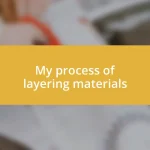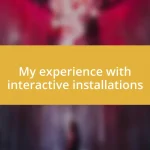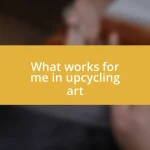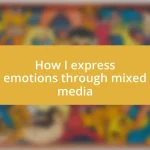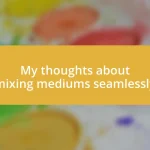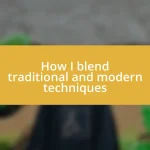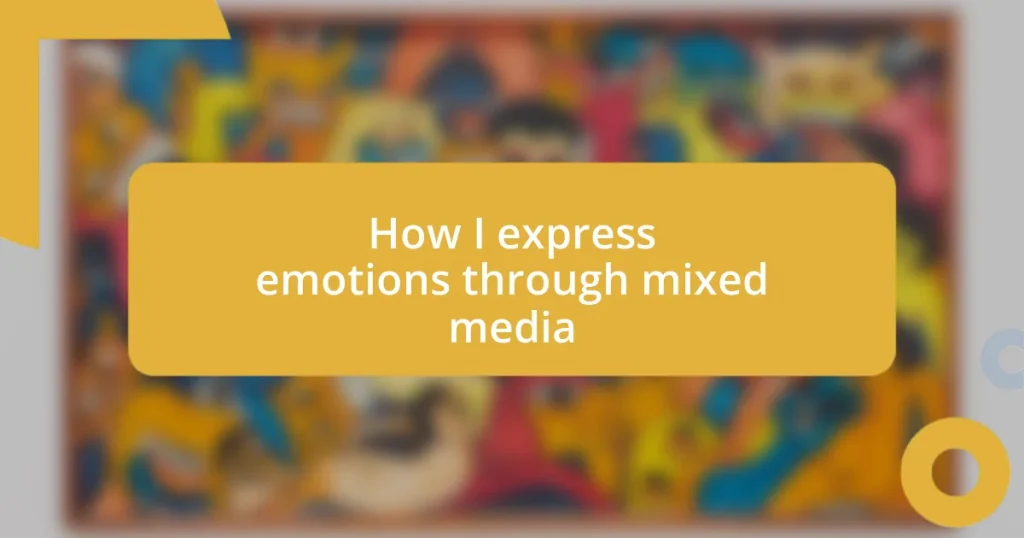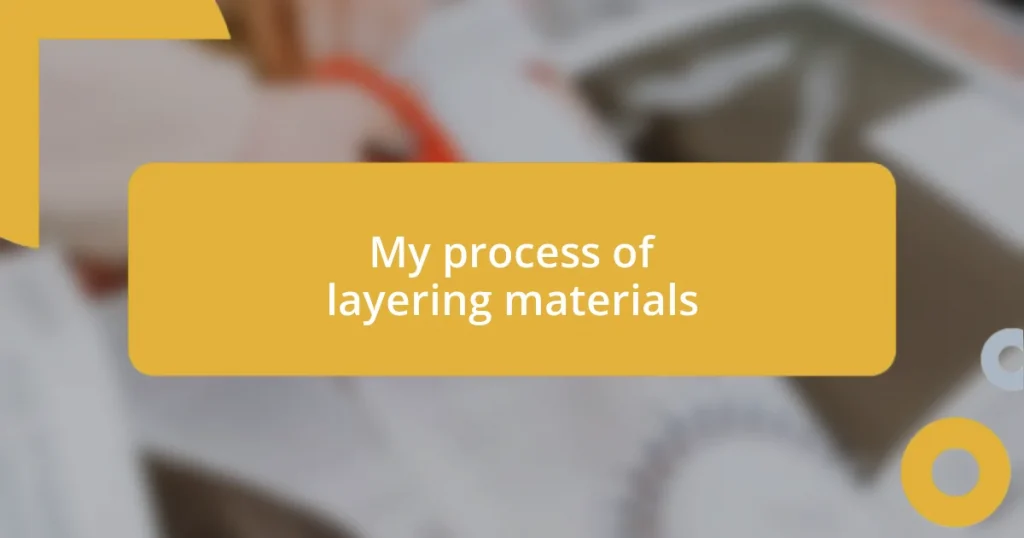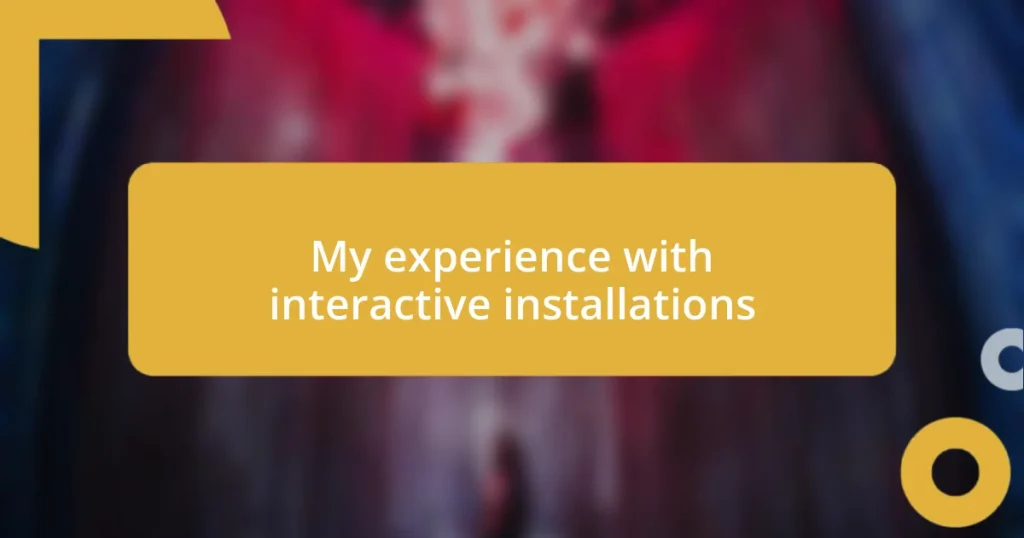Key takeaways:
- Mixed media art enables artists to express complex emotions using diverse materials and techniques, fostering a personal narrative that resonates deeply.
- Exploring different media types enhances emotional expression; each medium serves as a new lens for articulating feelings through layering textures, colors, and found objects.
- The process of creating cohesive artwork involves intentional material selection and arrangement, leading to a harmonious emotional narrative that fosters reflection and personal growth.

Understanding mixed media art
Mixed media art fascinates me because it embodies the freedom to express emotions using a variety of materials and techniques. I remember my first mixed media piece: I combined paint, fabric, and newspaper clippings to express my feelings about a significant life change. The excitement of layering different textures allowed me to convey a depth of emotion that a single medium simply couldn’t achieve.
What draws many artists to mixed media is the endless possibilities it offers. Have you ever thought about how materials can evoke different feelings? For instance, the roughness of sandpaper might convey a sense of struggle, while silky fabric could communicate comfort. I often find myself experimenting, letting the materials guide my emotions rather than strictly adhering to a specific technique.
Ultimately, mixed media art invites a dialogue between the artist and the materials, creating a personal narrative that resonates deeply. Each layer holds a story, a feeling, or experience that collectively paints a broader picture. For me, this blend of creativity and vulnerability is what makes mixed media such a powerful form of expression.

Exploring different media types
Exploring different media types is an exciting journey for any artist. I often find that certain materials call to me at different emotional stages. For example, there was a time when I was feeling particularly nostalgic, and I dug out some old letters and photographs. Incorporating these personal items into my artwork allowed me to weave a story that resonated deeply with my memories. The tactile experience of these pieces added layers of meaning that greatly enhanced the emotions I aimed to express.
Each medium I choose feels like a new lens for viewing my emotions. For instance, when I work with acrylic paints, I enjoy the vibrancy and intensity they bring to my pieces. However, when I switch to collage, I experience a sense of playfulness that allows for spontaneity in expression. This constant exploration keeps me engaged and helps me to articulate my feelings in ways that never feel stale or repetitive.
As I experiment with different colors, textures, and forms, I discover how they interact with my emotions. The juxtaposition of hard and soft materials resonates with my internal struggles and triumphs. Have you ever used something unexpected in your artwork? I remember once using shattered glass in a piece about heartbreak, and the sharp edges visually echoed my pain while still allowing light to shine through. It’s these captivating experiences that make exploring various media types not just a creative exercise, but a profound emotional exploration.
| Media Type | Emotional Impact |
|---|---|
| Acrylic Paints | Vibrant expression of intensity and passion |
| Collage Materials | Encourages playfulness and spontaneity |
| Fabric | Conveys warmth and comfort through texture |
| Photography | Captures fleeting moments, evoking nostalgia |
| Natural Elements | Creates a connection to nature and grounding emotions |

Techniques for emotional expression
I find that the techniques I use to express emotions through mixed media vary depending on what I’m feeling. For instance, I tend to gravitate towards impulsive and abstract approaches when I’m overwhelmed with joy. One time, I poured vibrant paint straight from the tube onto the canvas, then used my hands to blend and smear the colors. The physical act of painting felt liberating, allowing my exuberance to manifest in a whirlwind of hues. This spontaneous connection to my emotions deepened my understanding of how movement can communicate sentiment.
Here are some techniques I’ve embraced in my emotional expression:
- Layering: Building up textures allows me to represent complexity in feelings, reflecting how emotions often overlap.
- Collage: Combining old photographs, ticket stubs, or even fabric from a favorite shirt can reveal a narrative that words alone can’t express.
- Texture Choice: Using materials with different tactile properties helps convey my feelings; for example, rough textures might represent turmoil, while smooth surfaces signal calm.
- Color Symbolism: Delving into the psychology of color helps me choose shades that resonate with my mood, making the emotions visually articulate.
- Incorporation of Found Objects: Using everyday items can create a personal connection, imbuing the artwork with layered meanings rooted in my life experiences.
As I navigate through these techniques, I’ve come to appreciate the unique emotional insights each one offers. For example, during a particularly challenging time, I created a shadow box filled with mementos—small items that represented moments of pain intertwined with hope. The act of organizing these pieces became not just artistic expression, but also a healing ritual. Balancing materials and emotions, I feel, allows a space for reflection and growth that is often needed.

Incorporating texture and color
In my artistic journey, texture and color become my emotional voice. I vividly remember a time when I worked with soft, fabric pieces layered over rough canvas. The contrast told a story of vulnerability against the harshness of my experiences, beautifully illustrating the interplay of comfort and turmoil. Have you ever felt that a particular texture spoke to you?
When it comes to color, I can’t help but feel its power. Mixing hues to create a certain atmosphere is like a dance; each shade adds to the rhythm of my emotions. For instance, during a phase of self-discovery, I used yellows and oranges to express hope, blending in deeper blues to depict moments of doubt. The visual dance of these colors allowed me to confront conflicting emotions in a way that was raw and real, inviting the viewer into a dialogue with my heart.
I often find that the tactile quality of the materials I choose plays a significant role in cementing emotional connections. I recall experimenting with rough, jagged papers while feeling anger and frustration. The aggressive tearing released a pent-up energy and helped externalize those intense feelings. In stark contrast, when I favored smooth, flowing papers, the act of gliding my fingers over them evoked a sense of serenity. Each texture isn’t just a choice; it’s an embodiment of what I’m experiencing in that moment, making my art feel profoundly authentic. What textures stir your feelings?

Creating a cohesive artwork
Creating a cohesive artwork feels like weaving a tapestry of emotions, where every thread is essential to the whole. In my experience, unity emerges when I select a limited color palette that resonates with the feelings I want to convey. I recall a piece where I chose deep purples and subtle blues; their harmony created a calming atmosphere, reflective of a time when I was searching for peace amidst chaos. This intentional color choice helped anchor the artwork, drawing the viewer into a singular emotional journey.
Incorporating different materials can also enhance cohesion, but I’ve learned that balance is crucial. Once, I combined delicate paper with sturdy wood elements in a piece reflecting resilience. The strength of the wood held the fragility of the paper, creating a visual narrative that spoke to my own experiences of overcoming adversity. Have you ever felt that certain materials just belong together? Trusting my intuition in these selections often leads to unexpected but cohesive results.
Finally, I find that the arrangement of the elements within my piece plays a vital role in creating a sense of flow and connection. When I lay out my pieces, I like to envision how the viewer’s eyes will travel across the artwork. I still remember arranging a mixed-media collage, where each found object led to the next like a breadcrumb trail guiding the observer through my emotional landscape. This cohesive storytelling not only engages the audience but also deepens my own personal reflection on the emotions I’ve chosen to express. What experiences do your arrangements evoke?

Reflecting on emotional experiences
Reflecting on emotional experiences often feels like an introspective journey, one where I explore my deepest feelings and translate them into visual forms. I distinctly recall a period when I felt overwhelmed by anxiety, and through my art, I started layering chaotic splashes of paint. This messy expression acted as a cathartic release, helping me confront those feelings rather than burying them. Have you ever wondered how your emotions might transform into art?
The process of reflection allows me to uncover layers of meaning behind my emotional experiences. I remember one particular mixed-media project where I incorporated fragmented photographs of places that held memories of joy and sorrow. Each piece told a part of my story, and as I arranged them, I realized how interconnected my experiences were. It’s like piecing together a puzzle; have you ever felt that the act of creating helps you understand yourself better?
In moments of solitude, I often revisit previous works to re-examine the emotions I expressed. A painting I created during a period of heartbreak still resonates profoundly, as the colors evoke feelings of loss and healing at once. Engaging with this artwork feels like conversing with my past self, offering insights and reminding me of how far I’ve come. Isn’t it fascinating how reflecting on our emotional experiences through art can lead to personal growth?

